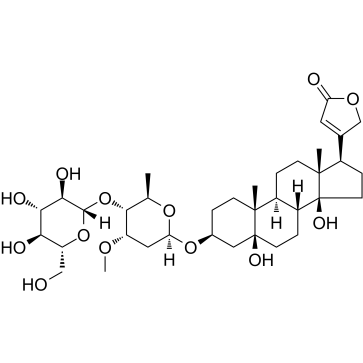CHEMICAL IDENTIFICATION
-
RTECS NUMBER :
-
FH4919700
-
CHEMICAL NAME :
-
Card-20(22)-enolide, 3-((2,6-dideoxy-4-O-beta-D-glucopyranosyl-3-O-methyl- beta-D-ribo- hexopyranosyl)oxy)-5,14-dihydroxy-, (3-beta,5-beta)-
-
CAS REGISTRY NUMBER :
-
13137-64-9
-
BEILSTEIN REFERENCE NO. :
-
0075742
-
LAST UPDATED :
-
199612
-
DATA ITEMS CITED :
-
6
-
MOLECULAR FORMULA :
-
C36-H56-O13
-
MOLECULAR WEIGHT :
-
696.92
-
WISWESSER LINE NOTATION :
-
L E5 B666TJ A1 E1 IQ MQ F- DT5OV EHJ& OO- FT6OTJ B1 CQ DO- BT6OTJ CQ DQ EQ F1Q
HEALTH HAZARD DATA
ACUTE TOXICITY DATA
-
TYPE OF TEST :
-
LDLo - Lowest published lethal dose
-
ROUTE OF EXPOSURE :
-
Subcutaneous
-
SPECIES OBSERVED :
-
Rodent - rat
-
DOSE/DURATION :
-
480 mg/kg
-
TOXIC EFFECTS :
-
Behavioral - convulsions or effect on seizure threshold Behavioral - ataxia Lungs, Thorax, or Respiration - dyspnea
-
REFERENCE :
-
JPETAB Journal of Pharmacology and Experimental Therapeutics. (Williams & Wilkins Co., 428 E. Preston St., Baltimore, MD 21202) V.1- 1909/10- Volume(issue)/page/year: 27,449,1926
-
TYPE OF TEST :
-
LDLo - Lowest published lethal dose
-
ROUTE OF EXPOSURE :
-
Subcutaneous
-
SPECIES OBSERVED :
-
Mammal - cat
-
DOSE/DURATION :
-
2500 ug/kg
-
TOXIC EFFECTS :
-
Behavioral - muscle weakness Cardiac - arrhythmias (including changes in conduction) Gastrointestinal - nausea or vomiting
-
REFERENCE :
-
JPETAB Journal of Pharmacology and Experimental Therapeutics. (Williams & Wilkins Co., 428 E. Preston St., Baltimore, MD 21202) V.1- 1909/10- Volume(issue)/page/year: 27,449,1926
-
TYPE OF TEST :
-
LDLo - Lowest published lethal dose
-
ROUTE OF EXPOSURE :
-
Intravenous
-
SPECIES OBSERVED :
-
Mammal - cat
-
DOSE/DURATION :
-
120 ug/kg
-
TOXIC EFFECTS :
-
Behavioral - muscle weakness Cardiac - arrhythmias (including changes in conduction) Gastrointestinal - nausea or vomiting
-
REFERENCE :
-
85ELDJ "Die Herzwirksamen Glykoside," Baumgarten, G., and W. Forster, Leipzig, Ger. Dem. Rep., VEB Georg Thieme, 1963 Volume(issue)/page/year: -,193,1963
-
TYPE OF TEST :
-
LDLo - Lowest published lethal dose
-
ROUTE OF EXPOSURE :
-
Unreported
-
SPECIES OBSERVED :
-
Mammal - cat
-
DOSE/DURATION :
-
121 ug/kg
-
TOXIC EFFECTS :
-
Details of toxic effects not reported other than lethal dose value
-
REFERENCE :
-
85ELDJ "Die Herzwirksamen Glykoside," Baumgarten, G., and W. Forster, Leipzig, Ger. Dem. Rep., VEB Georg Thieme, 1963 Volume(issue)/page/year: -,151,1963
-
TYPE OF TEST :
-
LDLo - Lowest published lethal dose
-
ROUTE OF EXPOSURE :
-
Subcutaneous
-
SPECIES OBSERVED :
-
Rodent - rabbit
-
DOSE/DURATION :
-
10 mg/kg
-
TOXIC EFFECTS :
-
Behavioral - tremor Cardiac - arrhythmias (including changes in conduction) Lungs, Thorax, or Respiration - dyspnea
-
REFERENCE :
-
JPETAB Journal of Pharmacology and Experimental Therapeutics. (Williams & Wilkins Co., 428 E. Preston St., Baltimore, MD 21202) V.1- 1909/10- Volume(issue)/page/year: 27,449,1926
-
TYPE OF TEST :
-
LDLo - Lowest published lethal dose
-
ROUTE OF EXPOSURE :
-
Subcutaneous
-
SPECIES OBSERVED :
-
Amphibian - frog
-
DOSE/DURATION :
-
34 mg/kg
-
TOXIC EFFECTS :
-
Cardiac - pulse rate Lungs, Thorax, or Respiration - respiratory depression
-
REFERENCE :
-
JPETAB Journal of Pharmacology and Experimental Therapeutics. (Williams & Wilkins Co., 428 E. Preston St., Baltimore, MD 21202) V.1- 1909/10- Volume(issue)/page/year: 27,449,1926
|


